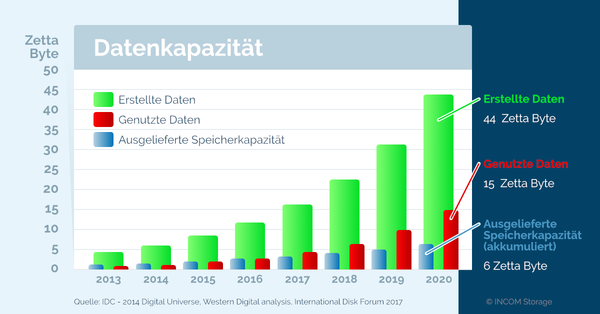In recent years, however, another raw material has increasingly come into the limelight, which has also shaken up the top positions of companies on the stock markets. This raw material is called information, which is collected, stored, traded and exploited or recycled in the form of data.
With the increasing spread of social network services (SNSs), the Internet of Things (IoT), but also ever higher camera resolutions, the amount of data generated is rising increasingly dramatically, which on the other hand can also increase productivity and open up new business opportunities.
Artificial intelligence: A lot helps a lot
Artificial Intelligence (AI/AI) in particular, with Deep Learning, is considered the key technology of our era. Through the creation of neural networks, defined data sources are analyzed and optimal answers are predicted. For each query, an algorithm is created that calculates a result based on the available data. If the same algorithm is provided with additional data, the result may vary. The accuracy of the analysis is determined by how much data is provided to the AI for evaluation.
The special feature of this raw material is above all that data can be used again and again and is not consumed. On the contrary, the mountain of data becomes more and more valuable as it grows, and so in addition to the obligation to archive certain data, there is also the freestyle of deciding which information might prove valuable in the future. One of the biggest challenges here is to store the increasingly large amounts of information in a way that is cost-effective and, above all, fit for the future.
Data explosion
With the proliferation of newer technologies, such as the IoT, data growth is expected to exceed the storage capacity available worldwide in the near future. This in turn poses the risk that valuable data will have to be discarded in the future and will thus be lost. Much of this data has an extremely low access frequency and is therefore also called cold data. The dramatic growth in demand for data storage combined with the nature of this data, necessitates a change in the way we store this information henceforth.
Since much of this information is continuous and its future use is often uncertain, it makes little sense to use expensive hard drives for this purpose, depending on the volume of data. Although a single hard disk is inexpensive, it is usually stuck in a not so inexpensive storage system with corresponding RAID or storage controllers, permanently consumes power, generates heat and, in the long term, must be migrated and expanded regularly, since the data stream does not stop.
It is precisely in these application areas that optical storage systems have increasingly become the focus of IT managers in recent years, as their capacity, durability and low energy consumption make them ideal for precisely this purpose. Optical data carriers are still popular in professional applications such as medicine, universities, libraries and archiving, and even Facebook archives several petabytes in optical libraries. In the last 3 years alone, INCOM brought over 25 petabytes of optical archive storage to the European market.
The Japanese Mitsubishi Chemical, to which Verbatim also belongs, develops special Achival Grade Blu-ray media for these applications, which are manufactured with special materials and high standards in quality control guarantee lifetimes of over 100 years. This allows the intervals of data migration, currently every three to five years for conventional hard disks, to be extended considerably.
Stored in magazines for the libraries, these storage media can also be removed from the system so that cost-effective copies of the data can be made and transported to their destination protected in the cartridges. The media conform to the ISO standard and are written in Universal Disc Format (UDF) in the recorders, which also permanently check the quality of the writing process, so that the media can be read in any standard Blu-ray drive.
Ecological, cost-conscious and safe
Also from a cost perspective, a long-term optical archive system is the ideal method for long-term data storage, drastically reducing data migration costs and power consumption costs compared to RAID (hard disk) and tape. Whether as a single medium, offline archive via an Epson Discproducer or Rimage BD production system, online in a StorEasy WormAppliance or nearline in a HIT library, Blu-rays provide a safe home for the information to be stored, because even hacker attacks or malware cannot harm the data on them.
We live in a time when data is one of the most valuable things we create and its preservation will have a significant impact on the way our society learns and develops. We strongly believe that optical media will have a clear role to play in this, as it offers a highly reliable and efficient method of long-term data storage that we can only benefit from.
Source: Data- The oil of our time, Hideharu Takeshima, Verbatim
